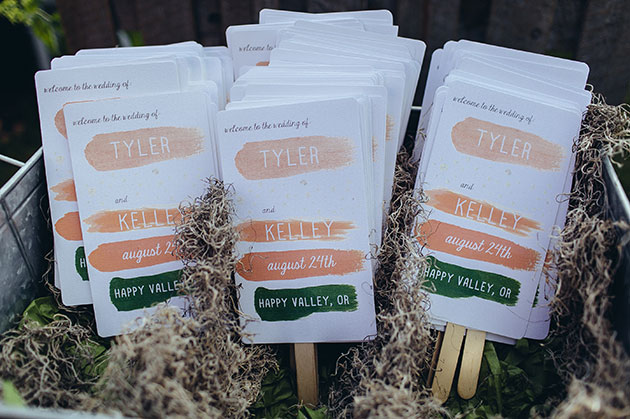
Photo: Maxwell Monty
Ceremony programs are often a wedding planning afterthought. Sure, you’ve spent a lot of time working on the wedding ceremony itself, but explaining the details to your guests? Not so high on a bride’s list of priorities. Thankfully, writing a great ceremony program is as easy as one, two, three!
First, choose a design. Opt for something that matches your invitation and other paper goods for a cohesive look throughout your celebration. You could go traditional with a single card or a folded booklet, or get creative with something like program fans for an outdoor ceremony. Once you’ve picked your design, here’s how easy it is to fill in the details:
Step One: Outline the Basics
Your programs should give guests information to guide them through your ceremony. They all follow a similar structure, so begin with this general format:
Your names, the date, and the location of your ceremony (either at the top or on the front cover)
A brief word of welcome, a blessing or prayer
An outline of the proceedings
The names of everyone participating in your ceremony
Step Two: Fill in the Details
When you’re getting into the details, you can keep things more general or get really specific. The proceedings could be straightforward (Welcome, Readings, Exchange of Vows, The Kiss!) or go into detail about the order of the processional, which readings are included, and any additional blessings or unity rituals you’re including. For a religious ceremony in particular, you should include the names of any readings or songs that will be included in the ceremony, with the optional addition of page numbers so guests can follow along in the scripture.
When you’re naming those participating in the ceremony, the traditional format is as follows: The parents of the bride, the parents of the groom, the bridesmaids and groomsmen (with the maid of honor and best man listed first), the flower girl and ring bearer, ushers and readers, and the officiant. If you are getting married by a religious officiant or someone whose job enables them to perform a marriage (like a judge), be sure to include their proper title (Father Michael Smith, Rabbi Andrew Zimmerman or The Honorable Samuel Brown). You could also list everyone’s names in the order in which they’ll walk down the aisle so guests can follow along as each person appears.
See more: Oops! If Your Stationery Was Sent To Press With an Error, Here’s What You Can Do
Step Three: Include the Add-Ons
Of course, every wedding needs a few personal touches! A longer note to guests or a note about the meaning of the venue will help further set the scene. Having an unplugged ceremony? Put this information front-and-center so the first thing your guests see is your request that the put away their cameras and phones.
When you’re naming your wedding party, consider adding a brief note about how you know each person, whether the maid of honor is your sister or the ring bearer is the groom’s nephew.
While religious programs usually do include the names of all the readings, it’s not required for secular weddings — though it is a nice addition. Include the title of the reading, the author, and the name of the person who will be reading it.
If you’re having a multicultural wedding or including traditions guests might not be familiar with, your program is a great place to include some explanations, whether it’s the symbolism of the chuppah or the meaning of the Filipino veil and cord.
And if there are people who have passed away who you would like to honor, include a note at the end of the program acknowledging their absence. You could specify particular names, or leave this as a more general note in honor of the people who can’t be with you to celebrate.
Lastly, if your ceremony and reception are in two different locations, you may want to include the name and address of your reception venue and the reception start time so guests know where to head after your first kiss (and what time to get there!).
